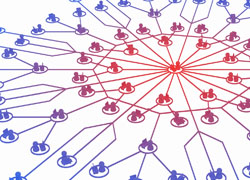IMDEA Networks

Event Category: External Presentation (External Speaker)
Unbounded Contention Resolution in Multiple-Access Channels
A frequent problem in settings where a unique resource must be shared among users is how to resolve the contention that arises when all of them must use it, but the resource allows only for one user each time. The application of efficient solutions for this problem spans a myriad of settings such as radio communication networks or databases.
Read more arrow_right_altStability in Networks with Aggregate Schedulers
Some among the most widespread applications of the Internet (real-time streaming multimedia applications) are based on packet exchanges that assume a very low packet delay. In order to offer some form of better service to this kind of traffic some architectural frameworks have been proposed, in which traffic sources obey some form of constraints on the maximum number of packets sent in every time interval, in which traffic is subdivided into classes, and where at any node all packets are served taking only into account the class to which they belong to. For these networks an open issue is their stability, that is the possibility to derive finite bounds to packet delay and queue size at each node.
Read more arrow_right_altTalk: CloudNet: Enterprise Ready Virtual Private Clouds
Cloud computing has great potential to change how enterprises run and manage their IT systems. Cloud computing platforms provide customers with flexible, on demand resources at low cost. However, while existing offerings are useful for providing basic computation and storage resources, they fail to provide the security and network controls that enterprise customers need. The CloudNet architecture provides more comprehensive control over network resources and security for users by utilizing Virtual Private Networks to securely and seamlessly link cloud and enterprise sites. CloudNet incorporates VM migration over WANs. CloudNet's capability for WAN migration transforms the scope of provisioning from a single data center to multiple data centers spread across the country or the world. This will open new opportunities for cross data center load balancing and dynamic application placement based on metrics like latency to users or energy cost. It also provides the foundation for a range of Disaster Recovery solutions. (The talk is based on joint work with Timothy Wood (UMass), Jacobus van der Merwe (AT&T Labs Research), and Prashant Shenoy (UMass) ).
Read more arrow_right_altSecurity Solutions for Geographic Routing in Wireless Multihop Networks
Mobile networks allow accessing and sharing information everywhere, but current infrastructures are limited by their legacies from circuit-switched networks. Although mobile ad-hoc networks (MANETs) solve many of these shortcomings, they face important challenges regarding routing and security. Localized geographic forwarding schemes are very promising for handling the routing challenge even in large multihop wireless networks, since they enable nodes to take routing decisions based only on information about their neighbors.
Read more arrow_right_altProportional Fairness and its Relationship with Multi-class Queueing Networks
We consider multi-class single server queueing networks that have a product form stationary distribution. A new limit result proves a sequence of such networks converges weakly to a stochastic flow level model. The stochastic flow level model found is insensitive. A large deviation principle for the stationary distribution of these multi-class queueing networks is also found. Its rate function has a dual form that coincides with proportional fairness. We then give the first rigorous proof that the stationary throughput of a multi-class single server queueing network converges to a proportionally fair allocation.
Read more arrow_right_altMeasurement-Driven Characterization of Emerging Trends in Internet Content Delivery
In the last decade, there have been radical changes in both the nature of the mechanisms used for Internet content distribution, and the type of content delivered. On the one hand, Peer-to-Peer (P2P) based content distribution has matured. On the other hand, there has been a tremendous growth in video traffic. The goal of my work is to characterize these emerging trends in content distribution and understand their implications for Internet Service Providers (ISP) and users. Such characterization is critical given the predominance of P2P and video traffic in the Internet today and can enable further evolution of content delivery systems in ways that benefit both providers and users.
Read more arrow_right_alt
Trade-offs in Implementing Atomic Multi-Writer, Multi-Reader Registers in Asynchronous Message-passing Systems
The technological advancement and information overload in recent years increased the popularity of Distributed Storage Systems where the data is replicated and maintained at multiple disks or servers residing at different network locations. While replication is sufficient to ensure data survivability, it raises an important question: "How can we efficiently maintain consistency among the replicas, despite system asynchrony and failures?"
Read more arrow_right_alt
Wireless Ad Hoc Networks in the Internet: Flooding and Routing Optimizations
As wireless ad hoc networking becomes more and more popular and ad hoc networks are used for an increasing number of applications, the integration of these networks in today's Internet, still mostly organized as a set of interconnected fixed and wired networks, becomes a key research field in the computer networking domain.
Read more arrow_right_altOnline Testing of Deployed Federated and Heterogeneous Distributed Systems
It is notoriously difficult to make distributed systems reliable. This becomes even harder in the case of the widely-deployed systems that are heterogeneous (multiple implementations) and federated (multiple administrative entities). The set of routers in charge of the Internet's inter-domain routing is a prime example of such a system.
Read more arrow_right_altValue of Information in Optimal Flow-Level Scheduling of Users with Markovian Time-Varying Channels
In this paper we design, characterize in closed-form, and evaluate a new index rule for Markovian time-varying channels, which gives rise to a simple opportunistic scheduling rule for flow-level scheduling in wireless downlink systems. For user channels we employ the Gilbert-Elliot model with a flow-level interpretation: the channel condition follows a general two-state Markov chain with distinct probabilities of finishing the flow transmission.
Read more arrow_right_alt











Recent Comments